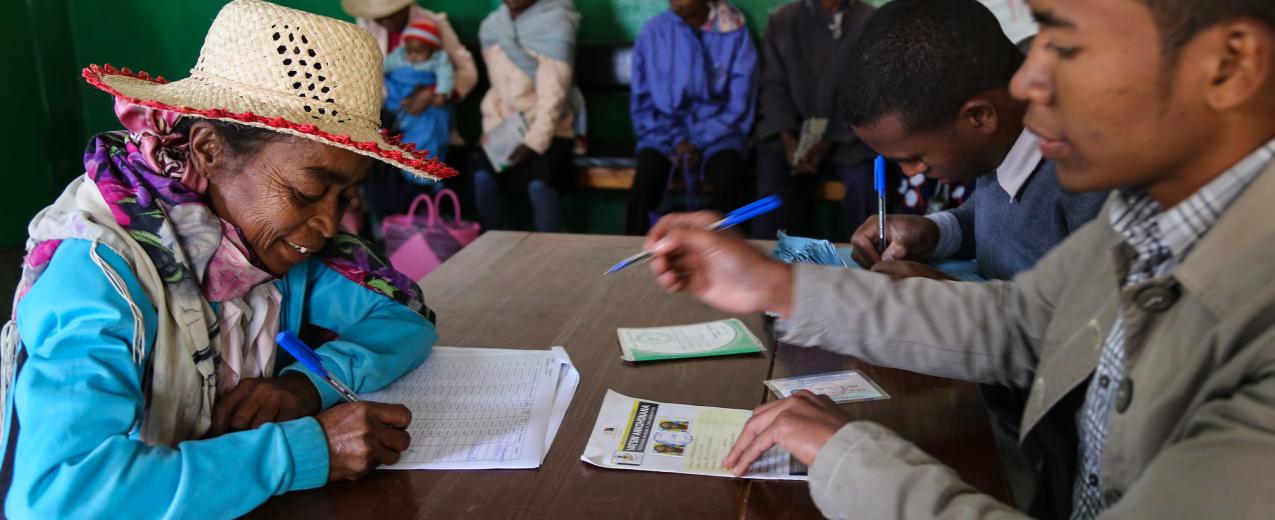
© Mohammad Al-Arief/The World Bank.
Qualitative and mixed methods tools
The growing number of tools for identifying social norms and measuring norm change include:
- The Learning Collaborative’s Social Norms Exploration Tool (SNET) outlines a set of steps and a menu of tools that can be used to find out which norms are dominant and why, and for analysing data collected.
- CARE’s Social Norms Analysis Plot (SNAP) provides a framework for distinguishing different types of norms, sanctions for violating a norm and understanding how much those sanctions affect behaviour. It can be used as a framework for monitoring and evaluation as well as understanding whether norms underpin a practice.
- Oxfam’s Empower youth for work social norms diagnostic tool focuses specifically on identifying social norms related to young women’s economic empowerment.
- The Learning Collaborative’s Resources for measuring social norms: a practical guide for programme implementers. This resource provides a collection of qualitative and quantitative tools for understanding norms and how they change. These include: vignettes, pile-sorting, body-mapping and social network analysis.
- The Learning Collaborative’s Overview of experiences diagnosing social norms. This resource curates a number of other tools and approaches that have been used in programming and research to identify social and gender norms.
- UNICEF’s Everybody wants to belong. This includes a section on understanding and identifying social norms, identifying the key stakeholders who uphold particular norms, and mapping social networks and reference groups.
- STRIVE’s (2017) Learning report: measuring gender-related social norms. This provides a collection of tools and sets of questions across different topics (such as family planning, child marriage, domestic divisions of labour, gender-based violence (GBV)). Some of these can be integrated into quantitative data collection – for example through questions on scenarios in surveys.
- CARE’s Tipping Point initiative’s Methods briefs. These briefs explain how to use Photovoice, a participatory photography tool, and Sensemaker, an approach to collecting and analysing narrative data to measure change in social and gender norms.
- CARE’s Monitoring, evaluation and learning framework for social analysis and action. This provides guidance on tools (mostly qualitative ones) for monitoring various dimensions of gender and social change, including social norms. This LINEA and CPC webinar also discusses these tools and the SNAP framework.
- UNICEF, UNFPA and Drexel University’s ACT Framework. This has been developed for measuring norms related to female genital mutilation/cutting (FGM/C), and could be adapted for use on norms around various other issues. The tools associated with the framework provide both validated questions for quantitative surveys and qualitative tools for exploring different aspects of norms, such as social networks and reference groups, sanctions, and perceptions of what others think. It also includes some specific tools for examining gender roles and encouraging participants to reflect on why FGM/C exists, as part of a norm change process, that can be used in group discussions or in individual interviews. The tools include 2x2 tables for examining whether or not social norms are a significant influence on a behaviour, discussed in more detail in this Learning Collaborative webinar.
- ODI’s Guide to doing qualitative research on gender norms with adolescent girls and their families. This tool gives guidance on: group discussions, including tools such as body mapping, a specific type of interview - the intergenerational trio, which can be used to explore changing norms across generations - a specific social network tool, exploring decision-making around marriage, and outlier case studies. These probe the factors that have led certain individuals to challenge constraining norms.
- Gender and Adolescence Global Evidence (GAGE) programme’s qualitative toolkit. This contains a number of qualitative tools that can be used to explore gender norms. It includes a dedicated section on mapping social norms, as well as tools such as body mapping and vignettes.
Vignettes
Vignettes have become one of the most common tools for understanding norms. They can be used in both qualitative and quantitative research to establish both the existence and strength of social norms, and the conditions under which they are influential. The table below lists some toolkits, guidance and studies using vignettes to explore gender norms.
Tools and guidance on using vignettes to measure changes in gender norms
| Topic | Resource |
|---|---|
| TOOLKITS | |
| Exploring norms around child marriage | CARE’s Social Norms Analysis Plot (SNAP) - also showcased in this Learning Collaborative webinar |
| Sexual and reproductive health and rights and gender-based violence | Oxfam’s Social norms diagnostic tool |
| Gender norms around food and nutrition | Gennovate’s guidance on using vignettes to explore gender issues |
| STUDIES | |
| Transactional sex | Stobenau et al. (2019) Developing experimental vignettes to identify gender norms associated with transactional sex in Central Uganda |
| Child marriage | Bicchieri et. al (2014) A structured approach to a diagnostic of collective practices |
| Bridewealth and gender-based violence | Horne et al. (2013) The Shadow of indebtedness: bridewealth and norms constraining female reproductive autonomy |
LEARNING COLLABORATIVE PROJECTS (see more in the Learning Collaborative’s map of social norms-focused interventions and research) |
|
| Acceptability of unmarried adolescents having sex and using contraception; acceptability of contraception within marriage in specific scenarios | Urban Reproductive Health Initiative |
| Acceptability of intimate partner violence in various scenarios | ReNEW, Sri Lanka |
| Adolescent dating behaviour and child marriage | Global Early Adolescent Survey |
| Girls’ education and child marriage | Grandmothers project, Senegal |
| Girls’ mobility, child marriage and sexual harassment | Tipping Point, Nepal |
